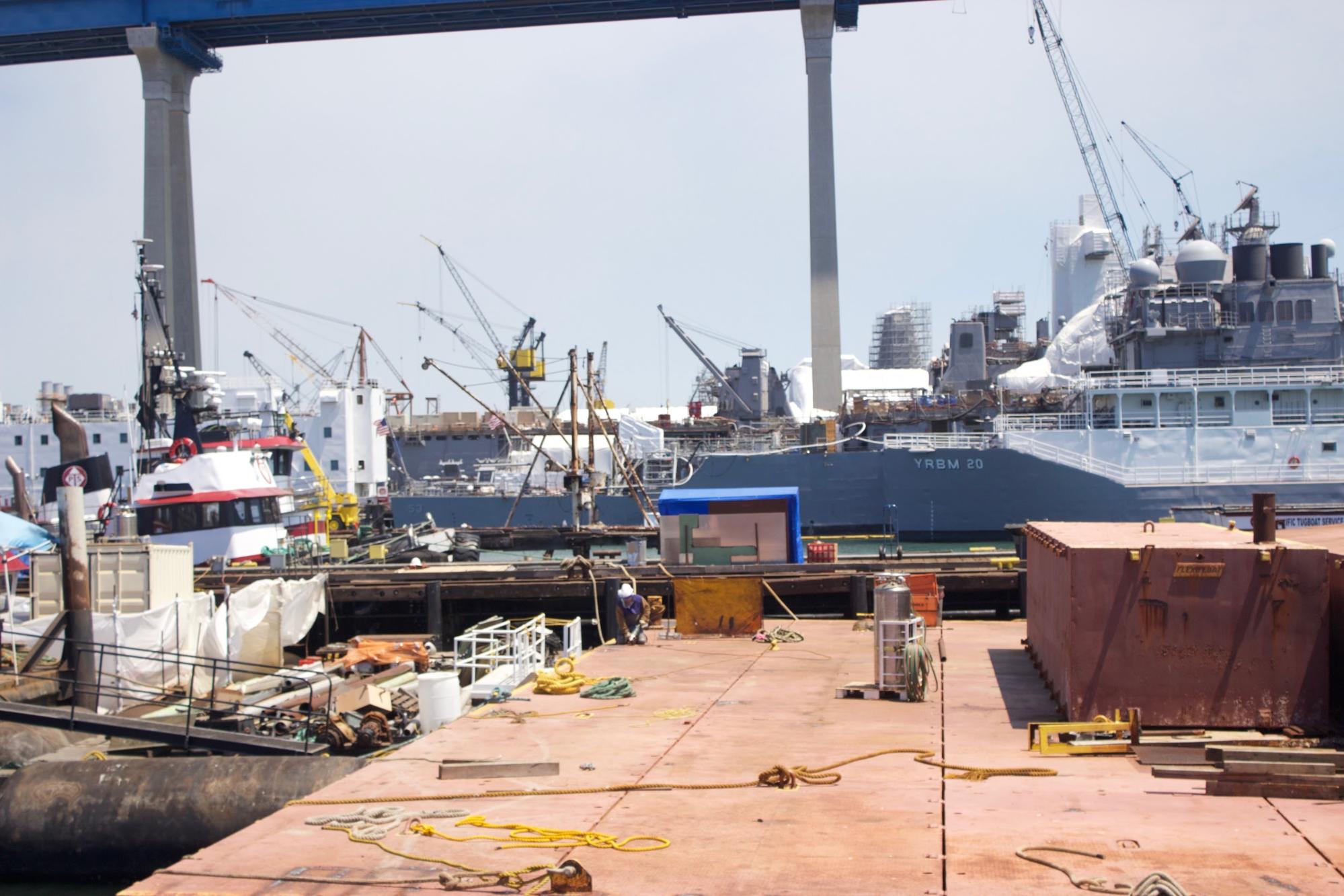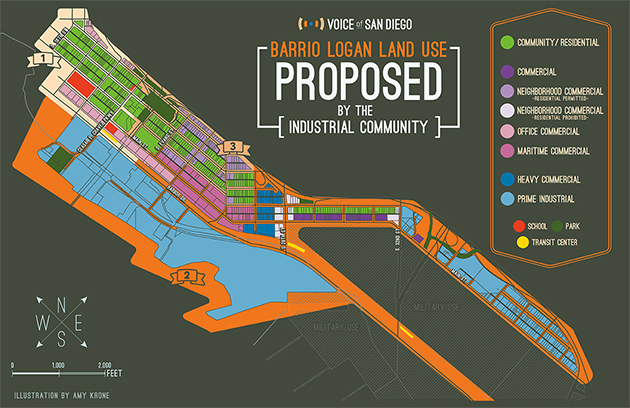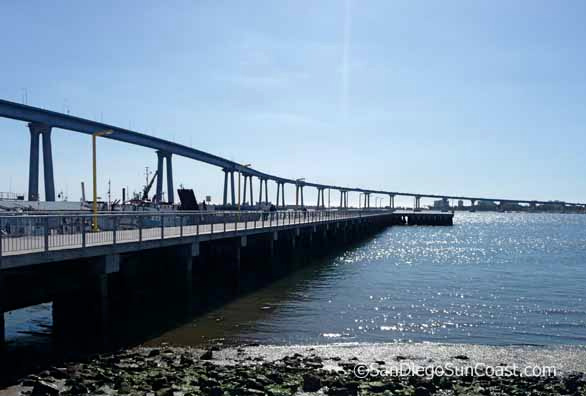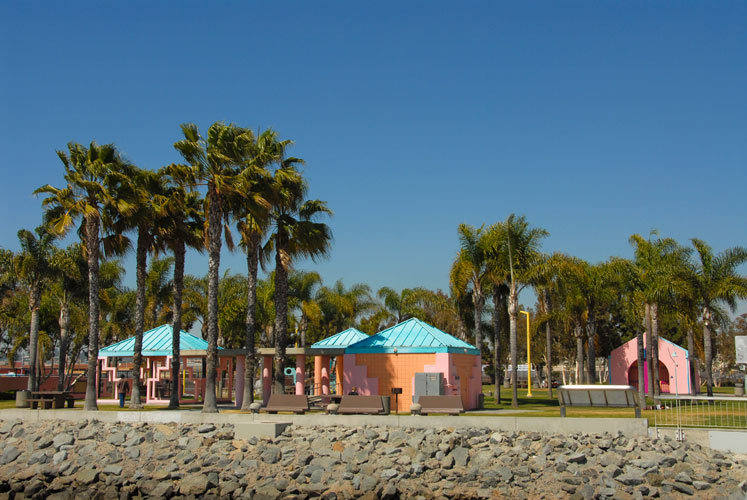Summary: Barrio Logan, once home to a working middle class neighborhood, has lost its waterfront access to marine industries as it became a mixed-districted neighborhood. Today, only a small-patch of waterfront can be freely accessed by the community at Cesar Chavez Park just north of the Coronado Bridge; however, with the presence of the nearby shipyards and marine service industries polluting the water, residents cannot enjoy beach access and recreational fishing, forcing them to travel farther to access resources many San Diegans have easy access to.

When you live in San Diego, there are some things you take for granted. The sunny, 75 degree year-round weather, the abundance of great taco stands to choose from on a Tuesday night, and a beautiful, expansive waterfront to enjoy. Though this may be true for a few neighborhoods, residents of Barrio Logan and Logan Heights have a very different experience with the local waterfront in their own communities.
Shadowed by the 5 freeway and the Coronado Bridge, these two communities are home to the only shipbuilding site on American Pacific coastline, NASSCO. Surrounding businesses cater to auxiliary service necessary to keep NASSCO running, and as a result the neighborhood is dominated by Naval repair shops and junkyards. The heavy industrial landscape chokes the waterfront, further cementing the neighborhood’s reputation as an industrial zone rather than a residential zone.
Jada Lawson, a Barrio Logan resident, discusses the negative impacts of the NASSCO shipyard on the community.


Cesar Chavez Park lies just north of the Coronado Bridge, on a rare patch of coastline not occupied by naval related services. It has a soccer field, a playground, and wide open spaces for residents to enjoy. Other than Chicano Park, Cesar Chavez Park is the only other park and the only open green space where residents can enjoy the sea breeze and unobstructed sunshine. Its key feature is the several-hundred-foot long pier that juts out into the San Diego Harbor. The park’s pier used to be a favorite fishing spot for locals and visitors alike, yet fishing from the pier was banned in 2008 following reports detailing poor water quality around the shipyards. However even before the institution of non-fishing ordinances, community members have known about the dangers of polluted waters in their community. Two local parents with their kids both agreed in that they would never let their kids play in the rocky “beach” of Cesar Chavez park. They pointed out the proximity of industrial docks and NASSCO shipyards to the left of the park as their main concern regarding pollution in the water.



[Clockwise from top right: View to the left of Cesar Chavez Park, with the Coronado Bridge and NASSCO can be see in the background; Cesar Chavez Park; the pier and “beach” as seen from the Park]
These parent’s concerns are not unwarranted. Multiple reports on soil contamination in the San Diego Bay have found elevated levels of environmental pollutants, including PCB’s (Polychlorinated Biphenyls). PCB’s are chemicals that can affect the endocrine and reproductive systems by acting as a mimic to naturally-produced endocrine chemicals. Accumulation PCB’s in the body can lead to damaged fetal development in pregnant women as well as damages caused in the immune system by affecting the thyroid. PCB’s enter the waters through leaky electronics that use it as an insulator; major contributor of PCB’s in Barrio Logan are the shipyards and small-scale industries that recycle retired naval hardware. This chemical can remain in the soil for a long time, and can only be removed via bioremediation or by dredging the soil. Bioremediation requires the the use of microbial organisms to break down toxic chemicals into simpler component that can be more easily handled. However some chemical pollution sink to the bottom of the bay and accumulate in the soil. To remove these chemicals soil from the bottom of the bay must be removed completely in order to clean the waters of the bay. The cost of these actions can amount to millions of dollars and the cleanup effort can last for decades, and finding an organization to take up the responsibility for the cleanup is nearly impossible. As a result, the small patch of beach that is available in Cesar Chavez Park is off-limits to children as it is contaminated.
Footage of waves from the polluted San Diego Bay washing onto the beach in Cesar Chavez Park.
Environmental Health Coalition and California CoastKeeper, another environmental justice organization, have been litigating against NASSCO and San Diego Port Authority to clean up the bay, but the legal battle continues on.
Another long-term resident, Terrell, remembered his time working at the Naval Yard south of Barrio Logan. During his time in the Navy, he recalled an incident in which his fellow sailor fell overboard from a ship into the harbor. After the sailor was brought onto deck, he had to get multiple immunization shots in order to counteract the effects of polluted water he came in contact with. This event left him with a fear of harbor waters and a desire to take action to clean it up.
The lack of open coastal access close to home has a real impact on the well-being of community members, both physical and mental. The pollution which makes the use of a single community “beach” unusable is an issue that needs to be addressed by the Port of San Diego and local industries that rely on the community of Barrio Logan to survive. Just as the industries need willing and healthy workers from the community, it needs to provide a safe and accessible waterfront its community members deserve, just as rest of San Diegan take their clean beach access for granted.
